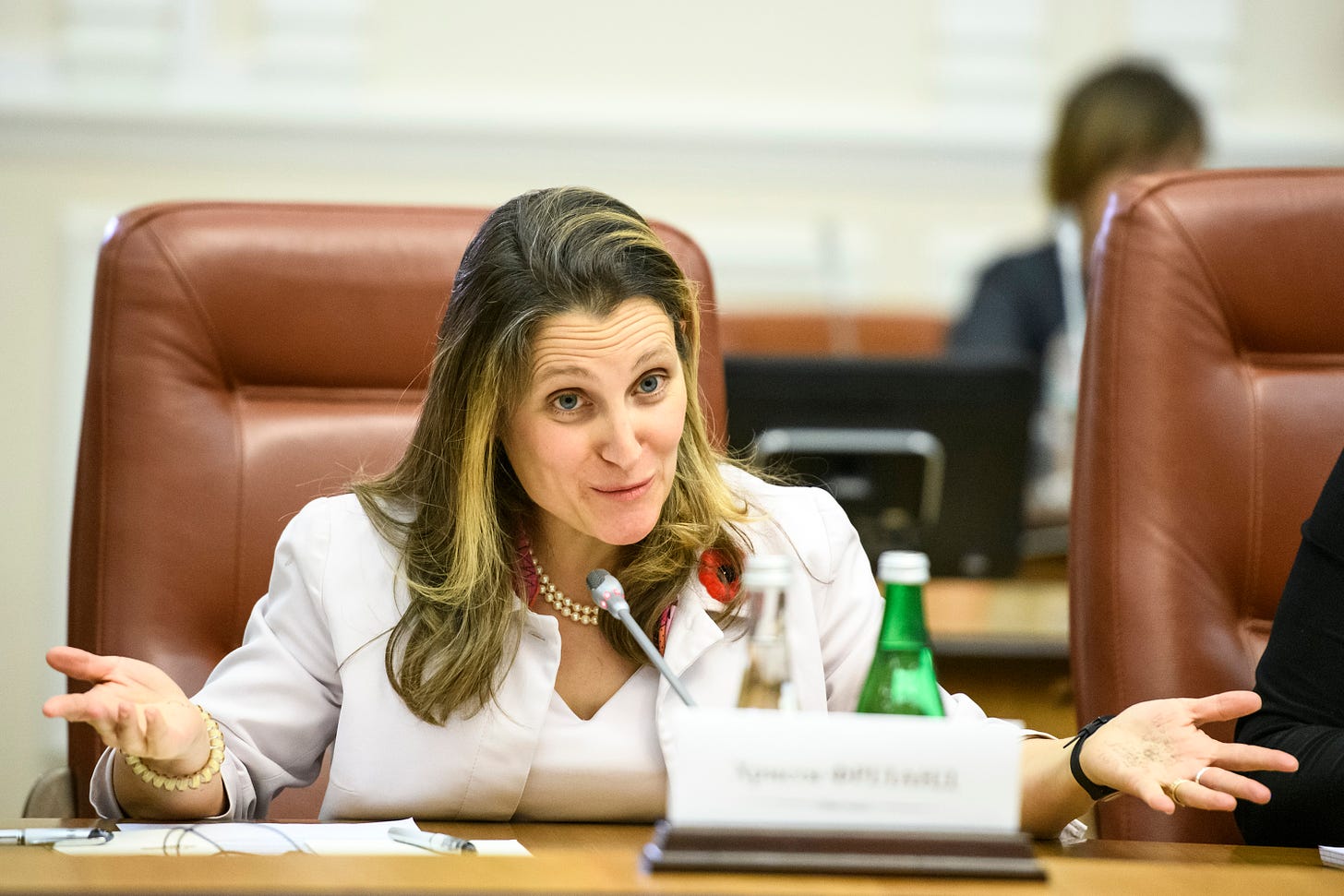Look, the thing you don’t understand is that government shouldn’t be in the business of picking winners.
“This approach is not about the government picking individual corporate winners in an effort to engineer a preferred vision of the economy in 2050,” it says right here on Page 19 of Chrystia Freeland’s 2023 federal budget.
Picking winners and engineering visions just did not work in the past. This is what you don’t understand. I’m sorry I even need to explain this to you. “That approach did not work in the past,” it says right here on Page 19, “and is even less likely to work in today’s environment of rapid technological change.”
This is all by way of explaining one of the biggest-ticket items in what is a very curious budget: $80 billion in tax credits over 11 years to encourage investments in low-carbon electricity, manufacturing, and other elements of a clean economy.
Now, I’m usually skeptical about anything any government promises “over 11 years.” That horizon is three elections away. But what’s striking about these jumbo tax credits — covering between 15% and 40% of spending, including explicitly on “large-scale” spending on nuclear and hydroelectric development by provincial crown corporations — is that the money will be available right away.
And the decisions about how to spend it — which dams, which cleaner factories, which interprovincial grids — will “remain in the market,” in the words of a senior official who explained the meat of this budget to reporters on Tuesday in an Ottawa hotel ballroom.
Not all the decisions, of course. To qualify for the full tax credits, companies will have to pledge to pay union-level wages and provide decent work conditions, as defined by the feds. And of course, no investment in an area that’s entirely outside the big policy baskets — “clean electricity,” “clean hydrogen,” “clean technology adoption” and so on — will qualify for these tax credits.
But overall, at first glance, on paper, this is by far the least interventionist, the least meddlesome, the least obviously doomed-in-advance initiative the Trudeau government has announced to hasten the advent of the vaunted low-carbon economy.
All it took to get here was a bunch of earlier false starts and three crises.
The false starts include the more cumbersome instruments the Trudeau government has tried before now, including the Canada Infrastructure Bank, the Canada Growth Fund, the government’s assorted attempts to “partner” with private investors and “accompany” them on their paths and “be there for the ribbon-cutting.” It turns out Team Trudeau overestimated the number of companies that would be excited by the prospect of being partnered and accompanied by, well, Team Trudeau.
The crises were COVID, Vladimir Putin’s stupid invasion of Ukraine, and the election of Uncle Joe Biden. One of these things is not like the others. The global surge of supply-chain protectionism in response to the virus’s rise and the great-power rivalry that led to war in Europe forced an epiphany: “The vulnerability created by dependence on authoritarian regimes for critical goods is no longer tenable,” as the (surprisingly svelte! Barely 250 pages) budget document puts it. Put another way: It turns out friendshoring is a real thing and it is driving large government decisions, not only in Canada.
As for Biden, his election replaced the chaos of his predecessor with the pressure of purpose. The president is dumping, what, maybe a third of a trillion dollars into the subsidy pool for clean technology. The European Union is following suit.
Freeland and her colleagues had spent half a decade singing about the glory that would await to first movers in this clean-tech transition — without doing much first moving. Suddenly the greater risk was that Canada would move last.
The 2022 budget and fall update were about describing this new investment landscape and proposing inadequate responses. See, again, the Canada Growth Fund. We need $100 billion a year in new investment, they’d say, and here’s a $15-billion fund for the next decade. Even if it works, and I’ve been a skeptic, it’s not commensurate to the challenge of converting an economy to new supply-chain and energy-profile needs.
This new knob goes to 11. Every year since 2021, two senior government officials have come to the budget lockup (fun detail: this year they called it an “embargoed reading,” which I guess is meant to be less threatening) to brief reporters on the big vision behind the budget. One of the officials never talks. We’re not supposed to tell you who the other is, though it shouldn’t be too hard to guess. This year, while Senior Official Who Talks was talking, this pyramid was projected on screens behind him or her.
This is all the ways the feds are trying to encourage electrification, clean manufacturing, critical minerals exploitation and so on.
The really heavy work is done with the carbon tax and regulations, like the requirement that all new passenger vehicles sold in Canada after 2035 be electric vehicles. That’s been going on for a while and it’s the base of the pyramid at the bottom.
“Targeted programming,” the bit at the top, is basically what François-Philippe Champagne does all day long, handing companies your money. I mean, sometimes the government still picks individual corporate winners?
For the past several years, the feds have been futzing around with “Strategic Finance,” which again, is finicky new quasi-banks that sometimes fund interesting projects but in general have not attracted the multiples of private investment the feds once hoped. My God they’ve put their hearts into it, but results are mixed at best.
It’s the second-lowest tier of the pyramid, the “Investment Tax Credits,” that are new this year. They’re a reflection that the need for new capacity is considerable — the budget mentions projections that by 2050 Canada’s electricity generation requirements will double, and electricity capacity requirements might triple. It’s also a sotto voce admission that even this federal government can’t tax or spend what’s needed to make investment on this scale happen. At some point, private business (and provincial crown corporations) will have to be enticed.
It beats me whether these tax credits will help. Brother Coyne is sure they aren’t even needed.


But they sure are sweeping. The clean electricity tax credit is for “non-emitting electricity generation systems: wind, concentrated solar, solar photovoltaic, hydro (including large-scale), wave, tidal, nuclear (including large-scale and small modular reactors).” Unlike with the infrastructure bank, which supported only “greenfield” investment in fun new projects even though investor dollars were mostly interested in existing “brownfield” developments, the new credit applies to “both new projects and the refurbishment of existing facilities.” And crucially, “Crown corporations and publicly owned utilities, corporations owned by Indigenous communities, and pension funds” would be eligible. Including provincial energy utilities. Including Ontario Hydro, Hydro-Québec and BC Hydro. All of them, but those three are the biggest and they’re already keenly aware of big supply gaps and big renovation needs.
Hey, subscribers, let’s chat. Substack has a new(ish) chat capability, and I figure this is as good a week as any to try it out. I’ll be online Wednesday from 10 a.m. EDT to noon to chat with paid subscribers about the Freeland budget, other elements of the current political moment, or whatever else is on your mind. Substack’s chat page is here; I’ll start a new thread tomorrow at 10 EDT; paying subscribers will be welcome to join in.
There’s a lot more in this budget, of course, including a bunch of inflation-fighting benefits that will dominate the evening news coverage, and a dental-care package that suddenly costs twice what was projected a year ago. Plainly it takes a lot to keep Jagmeet Singh smiling. The “fiscal discipline” measures, including a magical plan to roll back massive increases in government by consultants and the sort of across-the-board departmental cuts that indicate a refusal to think in detail about the structure of government, seem likely to come up snake-eyes.
Those are relatively ordinary concerns of ordinary budgets. This tax-credit stuff is more interesting. It shows Freeland and her boss, the prime minister, playing very much against type. They must know that these credits will be available to companies they don’t know, crown corporations run by governments they don’t like, and other strangers. It will be difficult to show up for ribbon-cutting ceremonies. Pushed to extremes, governments sometimes try things outside their comfort zone. The story of this government is a seven-year story of a deteriorating relationship with businesses that make their own decisions in competitive markets. But desperate times lead to desperate measures. Suddenly Trudeau and Freeland are willing to trust CEOs. Will wonders never cease.







Bait and Switch Budget v.6.0
Once again Ms. Freeland set us up with lofty talk about keeping powder dry and worries about inflation and the resulting recession.
The bold and fine print of the budget shows us that lessons are not being learned and that the huge deficits and accumulated debt is going to be someone else’s mess to deal with.
The nagging undertow to all this largesse and tax credits is the roll of the dice nature of the green shift in the economy. Where did this Liberal Government acquire the bonafides to completely restructure the economy in its own image? It certainly isn’t from strong fiscal management or building investor confidence to diversify the economy.
There is huge risk to Canadians for this obsession with green technology and the sunk costs going forward that will be underwritten by taxpayers. We aren’t talking about the risk/reward ratio at all, and we should because this could end up badly.
"...the new credit applies to “both new projects and the refurbishment of existing facilities.” And crucially, “Crown corporations and publicly owned utilities, corporations owned by Indigenous communities, and pension funds” would be eligible. Including provincial energy utilities."
Cynical? Moi? The only province where all its electrical power is generated by comps without an extension cord plugged into His Majesty's treasury? Alberta of course. Will Atco, TransAlta et al qualify? Oops. We forgot about those knuckle draggers out there.